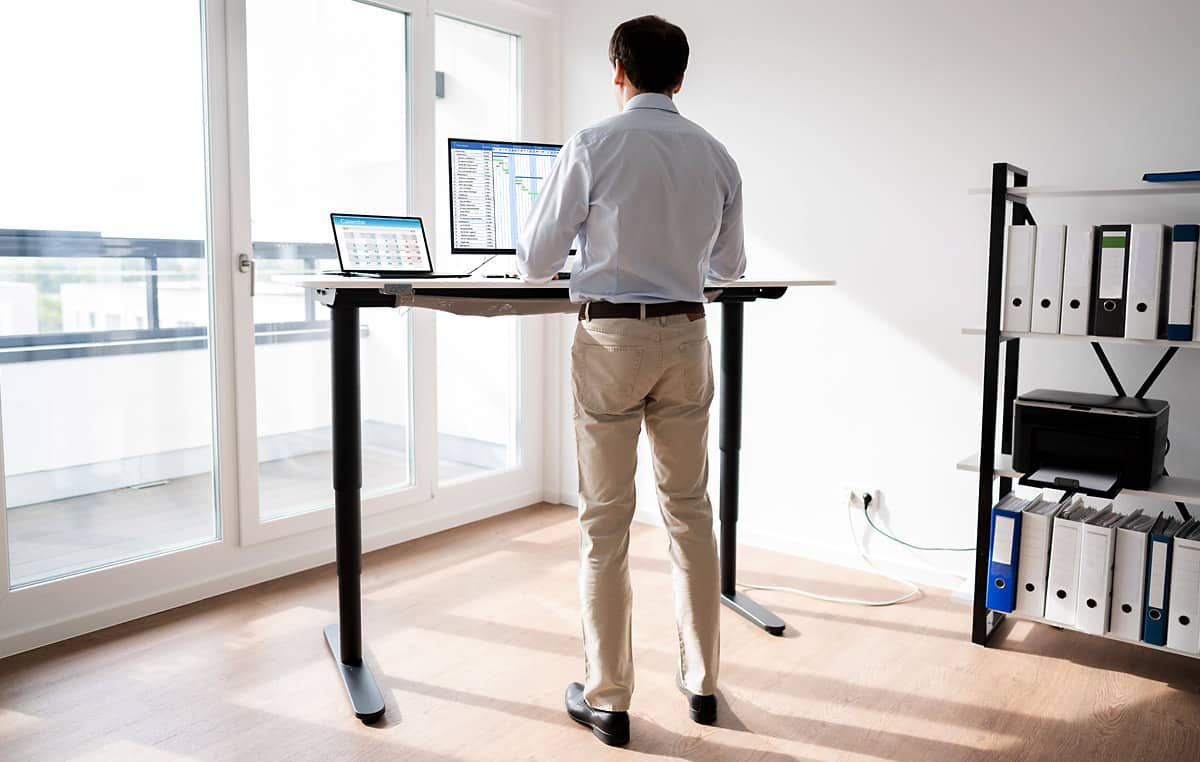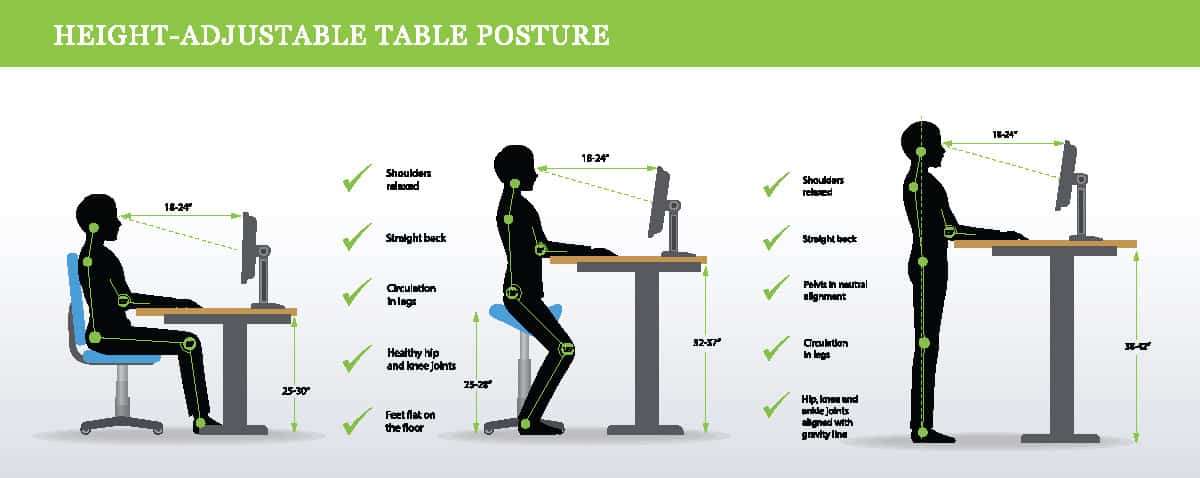
The Truth About Standing Desks: Risks vs Benefits
Are you looking to improve your wellness and productivity in 2021? Some experts say the answer is as simple as implementing standing desks.
Let’s first address the most obvious question you might be asking yourself:
What is a standing desk?
Well, it’s exactly what it sounds like – a desk set up that allows workers to stand while getting their job done. Though it should be noted, many standing desks are actually “sit to stand” desks, which means employees can manoeuvre the desk as they like throughout their workday.

According to a survey by the National Business Group on Health (NBGH), large employers spent on average $3.6 million on wellness programs in 2019. Spending millions of dollars annually with a goal of improving employee health and productivity has become a central tenet of many businesses. Could the answer be as simple as a desk change? We’re delving deeper into the topic.
Have you heard about Strategic Seating? Some organizations have increased productivity by 15% and added $1m profit to the bottom line, simply by changing where people sit. Check out this ebook to learn more.
Can a change in desk really have a huge impact?
What are the risks?
What data points exist on standing desks?
We’ll help break down everything you need to know about the standing desk trend that only appears to be gaining popularity in the workplace.
Who is Using Standing Desks?
Atop the list of major companies across the globe using standing desks is none other than Apple. The company’s CEO Tim Cook has been quoted as saying, “sitting is the new cancer.”
Cook announced publicly in 2018 that all Apple employees have standing desks. A Business Insider article quoted him as saying, “We have given all of our employees, 100%, standing desks. If you can stand for a while, then sit, and so on and so forth, it’s much better for your lifestyle…”
Workers at Google and Facebook hopped on the standing desk trend nearly a decade ago. A Wall Street Journal article from 2011 found, “Facebook officials say they have seen an upsurge in requests for standing desks to five to eight a week with a total of between 200 and 250 deployed at the company of more than 2,000 employees. Facebook also is trying out a treadmill station—where a worker can walk or run on a treadmill while tapping at a computer…” The article goes on to say, “Google spokesman Jordan Newman said that “many employees at Google opt for standing desks, and we offer them as part of our wellness program” though he said he didn’t know the exact number.”
Twitter, FF Venture Capital and Fast Company are among other well-known businesses that have incorporated standing desks into the workplace.
The Benefits of Standing Desks

There are many known advantages to using a standing desk, including making you feel more alert and helping you to problem-solve.
The company Uplift Desk lists the following 8 benefits:
- Increase Energy
- Improve Mood
- Harness Joints and Muscles
- Boost productivity
- Lose Weight
- Improve Mental Focus
- Lower Risk of Disease
- Reduce Caffeine Intake
Is Sitting Killing You?
According to a recent Washington Post article, the average American sits roughly 6.5 hours a day. The average teenager, aged 12 to 19, sits roughly 8 hours a day.
Why are those numbers important?
Research has shown that having a sedentary lifestyle can lead to numerous health problems. Inactivity can cause a host of issues including obesity, heart disease, high blood pressure, high cholesterol, stroke, and type 2 diabetes.
In fact, a study of over 100,000 people in the US found that those who sit for over six hours a day were more likely to have died over the course of the 14-year study – mostly of cardiovascular disease – even if some of them exercised regularly.
A Harvard Business Review article on the subject found, “The human body is designed to stand, not sit. Standing is better for the back than sitting. It strengthens leg muscles and improves balance. It burns more calories than sitting. It is also a great antidote to the formation of blood clots deep in the legs. When you sit for long periods, blood flow slows through the legs. Sluggish blood flow can set the stage for a blood clot to form. You’ve probably heard of this happening to people on long flights, but it can also happen in the office. Standing and walking squeeze valves in the leg veins, pushing blood upward toward the heart.”
Breaking Down the Research: The Positives of Using a Standing Desk
A TIME Magazine article, citing 2018 research says, “Office workers who used desks that could be adjusted for sitting or standing reported significant reductions in the amount of time they spent sitting, better health and improved work performance at the end of a year-long trial, compared to employees who sat at their desks as usual…”
The TIME article goes on to breakdown the tangible results of that study, “At the start of the study, people sat for an average of 9.7 hours each day, including time at home. But over the course of the year, people in the intervention group began sitting much less than people in the control group: After three months, they spent 50 fewer minutes seated each day. That number grew over time. After six months, they sat for 64 fewer minutes than the control group, and after a year, they sat for 82 fewer minutes. Those reductions may translate to real health benefits, the researchers write, since a recent research review linked sitting more than eight hours per day to a heightened risk of early death and cardiovascular disease. Type 2 diabetes risk also appears to increase the longer you sit each day.”
A 2019 study conducted by researchers from various universities found that, “sit-stand desks effectively change behaviours and discomfort, but these changes only mildly effect health outcomes.”
Breaking Down the Research: The Negatives of Using a Standing Desk
A 2018 CNN article says that standing desk recommendations are based on weak science. The article explains, “A 2016 meta-analysis of 20 studies, conducted by the Finnish Institute of Occupational Health and including more than 2,000 participants, found little evidence that standing or treadmill desks have any health benefit. Even the best studies they found were poorly designed, with small sample sizes and little to no followup to see whether standing desks had any real long-term effects. The researchers concluded that buying a standing desk may reduce your sitting time by as little as 32 minutes a day.”
The article notes that in regard to the calories that are actually burned standing vs. sitting, “Standing desk fans also claim that standing burns twice the calories of sitting, a study conducted at Harvard found that standing only burned eight more calories an hour than sitting. In other words, use of a standing desk for three hours burns an extra 24 calories,” they wrote, “about the same number of calories in a carrot.”
A New York Times article published in 2018 says that standing desks don’t cure anything. The article states, “Research, however, suggests that warnings about sitting at work are overblown, and that standing desks are overrated as a way to improve health.” The article goes on to say, “But standing is not exercise. Many health groups recommend that people at work take frequent walking breaks. Replacing sitting with standing does not fulfill that recommendation and may even mislead people into thinking they’re doing enough activity.”
Some of the Greatest Minds Prefer to Stand
Did you know that many famous thinkers have opted to stand at work? The list of greats who have used standing desks includes, Leonardo da Vinci, Winston Churchill, Ernest Hemingway, Donald Rumsfeld, Vladimir Nabokov, Benjamin Franklin and Thomas Jefferson.
Tips to Make Standing Work for You
- Make sure your keyboard and monitor are at the correct height
- Remember to stand properly, with your knees relaxed (not locked) and your weight evenly distributed
- Give yourself time to get used to standing
- Take regular breaks
SmartWay2 offers a unique workplace scheduling software for modern, agile and collaborative companies. Our flexible software can enable you to increase productivity, optimize your space and reduce your carbon footprint.


